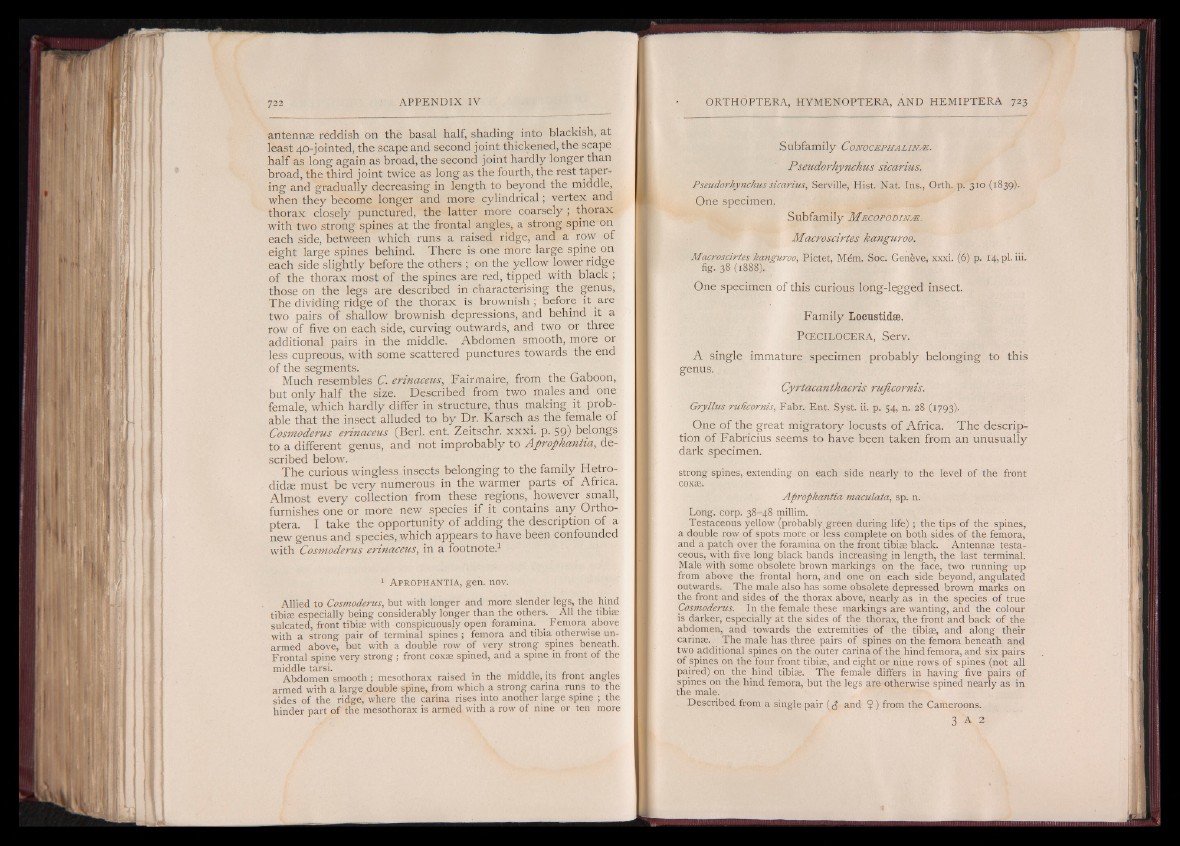
antennse reddish on the basal half, shading into blackish, at
least 40-jointed, the scape and second joint thickened, the scape
half as long again as broad, the second joint hardly longer than
broad, the third joint twice as long as the fourth, the rest taper-
ing and gradually decreasing in length to beyond the middle,
when they become longer and more cylindrical; vertex and
thorax closely punctured, the latter more coarsely ; thorax
with two strong spines at the frontal angles, a strong spine on
each side, between which runs a raised ridge, and a row of
eight large spines behind. There is one more large spine on
each side slightly before the others ; on the yellow lower ridge
of the thorax most of the spines are red, tipped with black ;
those on the legs are described in characterising the genus,
The dividing ridge of the thorax is brownish ; before it are
two pairs of shallow brownish depressions, and behind it a
row of five on each side, curving outwards, and two or three
additional pairs in the middle. Abdomen smooth, more or
less cupreous, with some scattered punctures towards the end
of the segments.
Much resembles C. erinaceus, Fairmaire, from the Gaboon,
but only half the size. Described from two males and one
female, which hardly differ in structure, thus making it probable
that the insect alluded to by Dr. Karsch as the female of
Cosmoderus erinaceus (Berl. ent. Zeitschr. xxxi. p. 59) belongs
to a different genus, and not improbably to Aprophantia, described
below.
The curious wingless insects belonging to the family Hetro-
didae must be very numerous in the warmer parts of Africa.
Almost every collection from these regions, however small,
furnishes one or more new species if it contains any Ortho-
ptera. I take the opportunity of adding the description of a
new genus and species, which appears to have been confounded
with Cosmoderus erinaceus, in a footnote.1
1 A p r o p h a n t ia , gen. nov.
Allied to Cosmoderus, but with longer and more slender legs, the hind
tibiae especially being considerably longer than the others. All the tibiae
sulcated, front tibise with conspicuously open foramina. Femora above
with a strong pair of terminal spines ; femora and tibia otherwise unarmed
above, but with a double row of very strong spines beneath.
Frontal spine very strong; front coxae spined, and a spine in front of the
middle tarsi. .. ,
Abdomen smooth ; mesothorax raised in the middle, its front angles
armed with a large double spine, from which a strong carina runs to the
sides of the ridge, where the carina rises into another large spine ; the
hinder part of the mesothorax is armed with a row of nine or ten more
Subfamily C o n o c e p h a l i n æ .
Pseudorhynchus sicarius.
Pseudorhynchus sicarius, Serville, Hist. Nat. Ins., Orth. p. 310 (1839).
One specimen.
Subfamily M e c o p o d i n æ .
Macroscirtes kanguroo.
Macroscirtes kanguroo, Pictet, Mém. Soc. Genève, xxxi. (6) p. 14, pi. iii.
fig. 38 (1888).
One specimen of this curious long-leggëd insect.
Family Locustidse.
P oe c i l o c e r a , Serv.
A single immature specimen probably belonging to this
genus.
Cyrtacantkacris ruficornis.
Gryllus rudcornis, Fabr. Ent. Syst. ii. p. 54, n. 28 (1793).
One of the great migratory locusts of Africa. The description
of Fabricius seems to have been taken from an unusually
dark specimen.
strong spines, extending on each side nearly to the level of the front
coxæ.
Aprophantia maculata, sp. n.
Long. corp. 38-48 millim.
Testaceous yellow (probably green during life) ; the tips of the spines,
a double row of spots- mote or less complete on both sides of the femora,
and a patch over the foramina on the front tibiae black. Antennæ testar
ceous, with five long black bands increasing in length, the last terminal.
Male with some obsolete brown markings on the face, two running up
from above the frontal horn, and one on each side beyond, angulated
outwards. The male also has some obsolete depressed brown marks on
the front and sides of the thorax above,' nearly as in the species of true
Cosmoderus. In the female these markings are wanting, and the colour
is darker, especially at the sides of the thorax, the front and back of the
abdomen, and towards the extremities of the tibiae, and along their
carinæ. The male has three pairs of spines on the femora beneath and
two additional spines on the outer carina of the hind femora, and six pairs
of spines on the four front tibiae, and eight or nine rows of spines (not all
paired) on the hind tibise. The female differs in having five pairs of
spines on the hind femora, but the legs are otherwise spined nearly as in
the male.
Described from a single pair (A and Ç ) from the Cameroons.